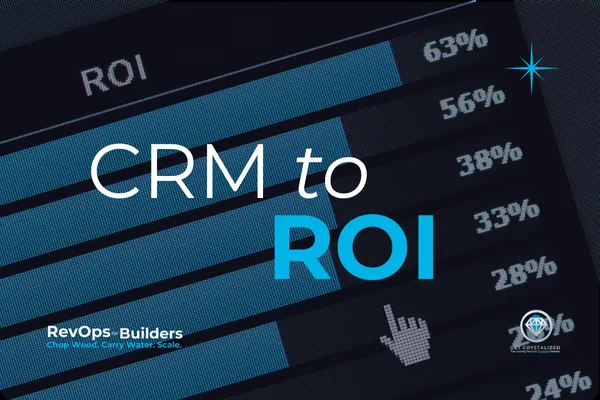
How to Turn Your CRM Data Into Real ROI | RevOps for Builders™
The Man Behind the Curtain
Remember that scene in The Wizard of Oz — when Dorothy pulls back the curtain to find a frantic man pushing buttons and pulling levers to keep the illusion alive?
That’s what most CRMs look like when you zoom in.
All those colorful dashboards and automated reports…
but behind the scenes?
A tangle of disconnected tools pretending to be control.
Influencers tell you to “post every day” or “launch more campaigns.”
But what good is attention if you can’t see which actions actually create customers — or profit?
“Visibility without structure is just theater. RevOps pulls back the curtain.”
The Disappointing Truth
Every founder hits this wall eventually: the realization that creating customers consistently takes more than hustle.
You’ve built the brand. You know your ICP. You’ve got a solid offer.
But even with all that in place, your CRM still doesn’t show which marketing activities actually lead to customers.
Your CRM isn’t broken — it’s just blind.
Most founders assume the CRM will reveal where revenue truly comes from. Instead, it quietly tracks activity — not outcomes.
From Founder-Led Hustle to Data Reality
In the early days, your CRM feels optional — a spreadsheet and hustle get the job done.
But as you grow, every new offer, lead source, and client interaction adds noise. You add a CRM expecting clarity, but it only mirrors the chaos.
Because most CRMs are set up around contacts and tasks, not customers and journeys.
Until your CRM reflects how buyers move from stranger → lead → client → repeat buyer, you’re just collecting data, not direction.
“The most valuable thing you can do with your CRM isn’t track more — it’s track what matters.”
Why CRMs Don’t Show ROI (Yet)
CRMs were built for sales teams, not for founders building systems.
They track activity, not alignment.
If your CRM doesn’t know your ICP, your offers, or your customer journey stages, then it can’t show ROI — because it doesn’t know what “return” even means.
That’s where RevOps begins: organizing your CRM so every stage connects to a real business question.
Who are we targeting? (ICP fields)
What are they buying? (Offer mapping)
Where do they fall off? (Journey stages)
What does it cost to acquire and retain them? (CAC, LTV, Payback inputs)
When your CRM is structured around your customer journey, every deal tells a story you can actually learn from.
Connecting CRM to RevOps Metrics
Once your CRM is architected around the journey, the three investor-ready metrics finally make sense:
CAC — Customer Acquisition Cost
Track every touchpoint from first contact to closed deal.
LTV — Lifetime Value
Connect retention and revenue to see how long each customer relationship truly lasts.
Payback Period
Measure how fast new sales recover what it cost to acquire them.
Metrics aren’t the answer — they’re the result of a connected system.
“Profit visibility isn’t about adding more data — it’s about structuring what you already have to tell the truth.”
Why I Created The Profitable CRM Series™
That realization hit me hard while building the Growth Accelerator.
I was doing all the right things — building systems, tracking touchpoints, optimizing tools — but the data still didn’t add up.
Then it clicked: the CRM wasn’t the problem; the design was.
It was a “data in, data out” issue.
If the structure doesn’t match your ICP, offers, and customer journey, no amount of automation will show true ROI.
That’s why I created the Profitable CRM Series™ — to help founders design CRMs that don’t just capture data, but connect it.
In the second session, we go deep on data design, because up to 80% of ROI accuracy comes from getting the structure right at the outset.
Once the foundation is solid, the numbers finally make sense — and profit visibility becomes real.
Make Profit Visible
If you need a place to start, grab the Profit Visibility Checklist™ — it’s the simplest way to connect your day-to-day business activity to the roll-up metrics investors care about most: CAC, LTV, and Payback Period.
It’s more than a checklist — it’s a lens for seeing how your operations drive revenue.
📊 Get the checklist and start building your own path to profit visibility.
And if you want to go deeper, that’s what the Profitable CRM Series™ was built for.
The current session is closed for enrollment, but you can join the waitlist for the next cohort here.
“When your data finally talks to each other, growth stops feeling like a guess.”
